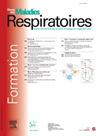Combined cellular and gene therapy to treat primary ciliary dyskinesia
IF 0.5
4区 医学
Q4 RESPIRATORY SYSTEM
引用次数: 0
Abstract
Primary Ciliary Dyskinesia (PCD) is a genetic disease caused by mutations that alter cilia beating, including in the respiratory airways. This results in poor mucus clearance, severe morbidity, and increased mortality. We hypothesized that bronchial cilia beating can be restored using genetically corrected iPSC differentiated into air - liquid interface bronchial epithelium model (iALI) for autologous cell therapy. We have previously demonstrated that corrected cells derived from a PCD patient iPS line can be differentiated into iALI with functional ciliary beating. The current aim of the project is to evaluate the engraftment potential of these corrected cells and their ability to repair the pathological model post-engraftment. Several key issues need to be addressed identifying competent cells for bronchial engraftment, exploring various strategies to pre-treat the bronchial epithelium, and assessing the recovery of the ciliary beating recovery to assure bronchial repair.
Our team has established the differentiation of iPSCs into iALI. We have generated a PCD patient iPSC line using Sendai viruses, a corresponding CRISPR/Cas9 corrected cell line, as well a wild-type iPSC line and its CRISPR/Cas9 mutated counterpart. We also generated a GFP-iPSC line that expresses the fluorescent GFP protein under the human elongation factor 1 alpha promoter (EF1a), which allows us to track the engraftment of GFP-labeled bronchial stem cells in both control and mutated iALI models. Our results suggest that lung progenitors at the ventralized anterior foregut endoderm stage could be the most efficient cells for engraftment. Their self-renewal capability and ability to differentiate into various cell types of the bronchial epithelium are promising for developing a long-term and effective therapy. Regarding bronchial erosion, we found that promoting cell engraftment is crucial due to the barrier function of the intact bronchial epithelium and the lack of selective advantage of corrected cells. Various chemical and enzymatic strategies have shown potential, but their safety for in-vivo use needs further assessment. Furthermore, GFP-expressing engrafted cells displaying cilia suggest successful differentiation into ciliated cells, though functional recovery still requires confirmation.
In conclusion, the engraftment of corrected lung progenitors into eroded bronchial epithelium appears to be a promising therapeutic strategy to PCD. Next step of the project involves developing this therapy for in-vivo application, assessing its safety and efficacy in an immunodeficient mini-pig model.
细胞与基因联合治疗原发性纤毛运动障碍
原发性纤毛运动障碍(PCD)是一种由改变纤毛跳动的突变引起的遗传性疾病,包括呼吸道。这导致粘液清除不良,严重发病率和死亡率增加。我们假设利用经基因校正的iPSC分化成气液界面支气管上皮模型(iALI)进行自体细胞治疗,可以恢复支气管纤毛的运动。我们之前已经证明,来自PCD患者iPS系的校正细胞可以分化为具有功能性纤毛跳动的iALI。该项目目前的目的是评估这些校正细胞的移植潜力及其移植后修复病理模型的能力。需要解决几个关键问题,确定适合支气管植入的细胞,探索各种策略来预处理支气管上皮,评估纤毛搏动恢复的恢复,以确保支气管修复。我们的团队已经建立了iPSCs向iALI的分化。我们使用仙台病毒、相应的CRISPR/Cas9校正细胞系、野生型iPSC细胞系及其CRISPR/Cas9突变细胞系,生成了PCD患者iPSC细胞系。我们还生成了一个GFP- ipsc细胞系,该细胞系在人延伸因子1 α启动子(EF1a)下表达荧光GFP蛋白,这使我们能够在对照和突变iALI模型中跟踪GFP标记支气管干细胞的植入。我们的结果表明,前肠前内胚层阶段的肺祖细胞可能是最有效的移植细胞。它们的自我更新能力和分化成支气管上皮各种细胞类型的能力有望开发出长期有效的治疗方法。对于支气管侵蚀,我们发现促进细胞植入是至关重要的,因为完整的支气管上皮具有屏障功能,而校正后的细胞缺乏选择优势。各种化学和酶的策略已经显示出潜力,但它们在体内使用的安全性需要进一步评估。此外,表达gfp的移植细胞显示纤毛,表明成功分化为纤毛细胞,尽管功能恢复仍有待证实。总之,将校正后的肺祖细胞移植到侵蚀的支气管上皮中似乎是一种很有希望的治疗PCD的策略。该项目的下一步是开发这种疗法的体内应用,评估其在免疫缺陷迷你猪模型中的安全性和有效性。
本文章由计算机程序翻译,如有差异,请以英文原文为准。
求助全文
约1分钟内获得全文
求助全文
来源期刊

Revue des maladies respiratoires
医学-呼吸系统
CiteScore
1.10
自引率
16.70%
发文量
168
审稿时长
4-8 weeks
期刊介绍:
La Revue des Maladies Respiratoires est l''organe officiel d''expression scientifique de la Société de Pneumologie de Langue Française (SPLF). Il s''agit d''un média professionnel francophone, à vocation internationale et accessible ici.
La Revue des Maladies Respiratoires est un outil de formation professionnelle post-universitaire pour l''ensemble de la communauté pneumologique francophone. Elle publie sur son site différentes variétés d''articles scientifiques concernant la Pneumologie :
- Editoriaux,
- Articles originaux,
- Revues générales,
- Articles de synthèses,
- Recommandations d''experts et textes de consensus,
- Séries thématiques,
- Cas cliniques,
- Articles « images et diagnostics »,
- Fiches techniques,
- Lettres à la rédaction.
 求助内容:
求助内容: 应助结果提醒方式:
应助结果提醒方式:


